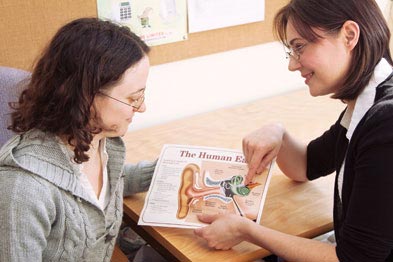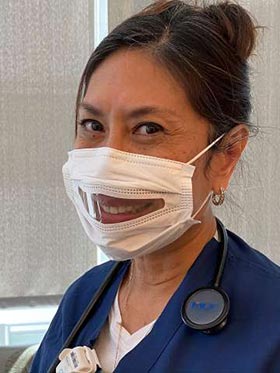
Health-care professionals use the process of informed consent to communicate the risks and benefits of procedures to patients. However, barriers may hinder patients’ understanding and prevent them from making informed decisions. During a student clinical placement, we witnessed the impact a hearing impairment had on gaining informed consent. This article explores, from a student nurse perspective, the challenges of gaining informed consent and offers possible solutions to ensure patients have the opportunity to make educated decisions.
Clinical scenario: Mrs J, a 35-year-old woman, was admitted to the ward for a nephrostomy procedure. She was registered as deaf following meningitis as a child. Mrs J’s hearing impairment caused challenges in obtaining a health history and informed consent for this procedure. An interpreter could not be present at all times, making gaining consent from Mrs J before providing nursing care problematic. Indeed, the student nurse observed registered nurses provide care to Mrs J without obtaining consent.
We asked the following questions:
- How is patient safety affected by a hearing impairment?
- Which patient rights are at risk?
- What competencies and codes are breached when nurses do not obtain informed consent?
- How can nurses prioritise informed consent when they have a high patient load?
Patient safety: Patient safety is paramount, and obtaining informed consent is considered a patient safety issue.1 Patient safety is defined as the prevention of errors and adverse effects related to patient care.2 Impaired hearing can affect the gaining of informed consent. If the patient inadvertently mishears information, this could consequently threaten patient safety on several levels. On one occasion, the student nurse observed Mrs J receiving nephrostomy wound care from the registered nurse who had not obtained consent. This interaction caused the student nurse to question if informed consent was obtained when health-care professionals were providing care to hearing-impaired patients.
Scholars have identified that deaf and hard-of-hearing individuals tend to sign consent forms without being fully informed.3 They can also be at risk of misdiagnosis or mistreatment due to incomplete or incorrectly obtained medical history. Unnecessary lab tests and dissatisfaction with health-care services are also common in the deaf community, and deaf patients have a harder time booking appointments and understanding health-care advice.4 A lack of effective informed consent can, therefore, lead to poorer health outcomes.
Patient rights: Health-care professionals have a moral and legal obligation to obtain informed consent to maintain patient rights.5 If a patient is asked to make health-care decisions without full access to the relevant information, their rights are being breached, and care becomes unethical. NZNO’s Code of Ethics6 and the Code of Health and Disability [HDC] Services Consumers’ Rights7 describe what patients are entitled to during hospitalisation. The HDC code’s fifth to seventh rights encapsulate a patient’s right to informed consent.
The right to be fully informed, treated with respect and other principles in NZNO’s code are breached when provisions are not made to ensure a patient has understood information provided. It is important to understand that a hearing impairment does not affect a person’s ability to reason and make informed decisions.7
Competencies and codes: Nurses spend more time with their patients than do other members of the health-care team, and nurses are accountable for obtaining informed consent before beginning nursing interventions.7 Without informed consent, nurses breach the Nursing Council’s competencies for nurses.8 Competency 3.1 states health consumers must have an adequate explanation of the proposed treatment options, and competency 3.2 states nurses must respect health consumers’ rights to participate in decision making.8 In the absence of informed consent, both of these competencies are breached. Moreover, competency 3.5 outlines that, where a patient is not competent to make an informed decision, the nurse must take reasonable steps to ensure the care is in the best interests of the patient.
Breaching these competencies means nurses have not worked with their patients to enable them to make informed decisions and give informed consent.9 Without obtaining informed consent, the Health Practitioners Competence Assurance Act 2003 is also breached, with serious implications for both the patient and the nurse involved.
Prioritising nursing tasks: For patients to be fully informed before giving consent, the nurse must be able to communicate effectively. Nurses must be thoroughly involved in the informed consent process and advocate for their patients. This may prove especially difficult in busy clinical environments. Increased workload, high stress levels and time constraints reduce a nurse’s capacity to communicate effectively with patients.10 Indeed, nursing shortages compound this problem.11 Therefore, these potential barriers to gaining informed consent must be mitigated by health-care professionals to improve their delivery of care.

The National Institute of Health, based in the United States, offers guidelines and procedures that can improve communication between the hearing-impaired patient and the nurse.12
Even if consent is given, the HDC code will be breached if the patient misunderstood and/or was not fully informed.13 Without proper procedures to help hearing-impaired patients, gaining consent will be challenging, which risks patient safety and breaches relevant codes.
The COVID-19 pandemic has put unprecedented pressure on health-care systems all around the world.14 In light of this, finding effective ways to communicate relevant information to patients has never been more important. In many situations, health-care professionals must wear personal protective equipment, including a face mask.14 This poses a barrier to lip reading. To combat this, clear face masks are used for the deaf and hard of hearing.
The importance of hand hygiene is also highlighted. Posters, sign language and simple images function to remind deaf patients to wash their hands regularly.
Recommendations
Allowing a hearing-impaired patient to choose their preferred communication method (sign language, visual prompts or lip-reading), will foster a positive nurse-patient relationship.15 The body language of the nurse, including eye contact and appropriate nodding, is crucial in building rapport with the patient. Without this, hearing-impaired patients are more likely to feel anxious during their hospitalisation.16 The nursing workforce should be better educated about communicating with hearing-impaired patients to provide quality care. Visual cues, such as simple diagrams, provide a platform for hearing-impaired patients to give informed consent. The general emphasis, when providing care to hearing-impaired patients, is the importance of gaining informed consent throughout their care. The gold standard for communicating important clinical information to the hearing impaired is to use an interpreter.17 It may also be useful for the nurse to regularly check if the patient has understood the information.
During clinical placements, nursing students observe a range of approaches to gaining informed consent. Working with patients with various levels of hearing impairment increased our awareness of the importance of effective communication. To relay information to deaf patients, we used visual cues and writing on paper. As students, we have a responsibility to advocate for our patients and develop nursing practice which prioritises patient safety.
Conclusion
New Zealand policies and codes clearly outline the role of the nurse and how to prioritise informed consent. Alternative ways of communication and thus ensuring patient safety are emphasised. Various recommendations aid in breaking down barriers associated with informed consent, including visual prompts, lip reading and increased awareness about communication with the hearing-impaired. Implementing these methods will improve nursing practice by advocating for and protecting all patients, regardless of their capacity to make informed decisions.
Elizabeth Henning, Jessica Wu, Georgia Battin, Kris Munar, Chloe Oh, and Emma Stevenson are second-year nursing students at the University of Auckland. They wrote this article as part of an assignment, working with their lecturer Kim Ward.
References
- Shah, P., Thornton, I., & Hipskind, J. E. (2020). Informed consent. StatPearls Publishing. PMID: 28613577
- Lawati, M. H. A. L., Dennis, S., Short, S. D., & Abdulhadi, N. N. (2018). Patient safety and safety culture in primary health care: a systematic review. BMC Family Practice, 19, 104. doi:10.1186/s12875-018-0793-7
- Nijhawan, L. P., Janodia, M. D., Muddukrishna, B. S., Bhat, K. M., Bairy, K. L., Udupa, N., & Musmade, P. B. (2013). Informed consent: Issues and challenges. Journal of Advanced Pharmaceutical Technology & Research, 4(3), 134-140. doi:10.4103/2231-4040.116779
- Laur, A. (2017). Healthcare access for deaf patients – The legal and ethical perspectives. Medico-Legal Journal, 86(1), 36-41. doi:10.1177/0025817217743416
- Zotti, V., Zotti, M., & Worswick, D. (2012). Obtaining informed medical consent: a legal perspective. Law Society of South Australia Bulletin, 34(1), 22-24.
- New Zealand Nurses Organisation. (2019). Code of Ethics (PDF, 809 KB).
- Health and Disability Commissioner. (1996). Code of Health and Disability Services Consumers’ Rights. Regulations.
- Ingravallo, R., Gilmore, E., Vignatelli, L., Dormi, A., Carosielli, G., Lanni, L., & Taddia, P. (2014). Factors associated with nurses’ opinions and practices regarding information and consent. Nursing Ethics, 21(3), 299-313. doi:10.1177/0969733013495225
- Nursing Council of New Zealand. (2012). Code of Conduct for Nurses.
- Hodgson, J., Mendenhall, T., & Lamson, A. (2013). Patient and provider relationships: consent, confidentiality, and managing in integrated primary care settings. Families, Systems & Health, 31(1), 28. doi:10.1037/a0031771
- Norouzinia, R., Aghabarari, M., Shiri, M., Karimi, M., & Samami, E. (2015). Communication Barriers Perceived by Nurses and Patients. Global Journal of Health Science, 8(6), 65–74. doi:10.5539/gjhs.v8n6p65
- Chan, E. A., Tsang, P. L., Ching, S. S. Y., Wong, F. Y., & Lam, W. (2019). Nurses’ perspectives on their communication with patients in busy oncology wards: A qualitative study. PloS one, 14(10), e0224178. doi:10.1371/journal.pone.0224178
- National Institutes of Health. (2019). Guidelines on Communicating Informed Consent for Individuals Who Are Deaf or Hard-of-Hearing and Scientists.
- New Zealand Nurses Organisation. (2019). Guideline – Code of Ethics (PDF, 809 KB). [eBook] (5th ed., pp. 1-23). Wellington: Author.
- Godderis, L., Boone, A., & Bakusic, J. (2020). COVID-19: a new work-related disease threatening healthcare workers. Oxford University Press Public Health Emergency Collection. doi:10.1093/occmed/kqaa056
- Brown, D., & Edwards, H. (2015). Lewis’s medical-surgical nursing: Assessment and Management of Clinical Problems. (Australia and New Zealand 4th ed). Mosby.
- Grady, M. S., Younce, A. B., Farmer, J., Rudd, A. B., & Buckner, E. B. (2018). Enhancing communication with the deaf through simulation. Nurse Educator, 43(3), 121-122. doi:10.1097/NNE.0000000000000442
- Hommes, R. E., Borash, A. I., Hartwig, K., & DeGracia, D. (2018). American Sign Language Interpreters Perceptions of Barriers to Healthcare Communication in Deaf and Hard of Hearing Patients. Journal of Community Health, 43(5), 956-961. doi:10.1007/s10900-018-0511-3



